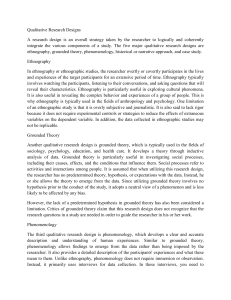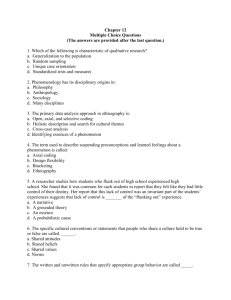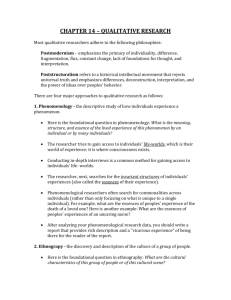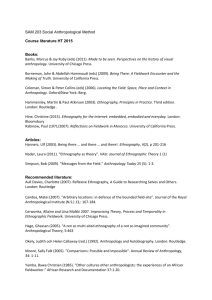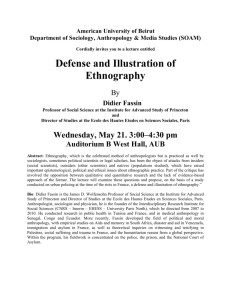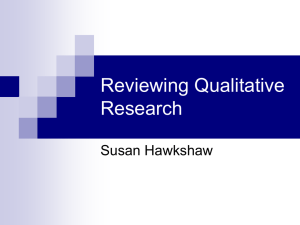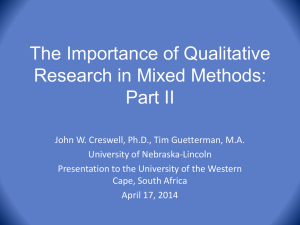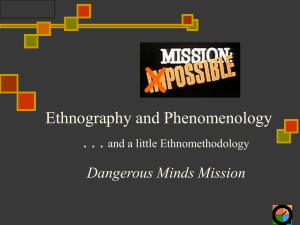SS376 L16 - WordPress.com
advertisement
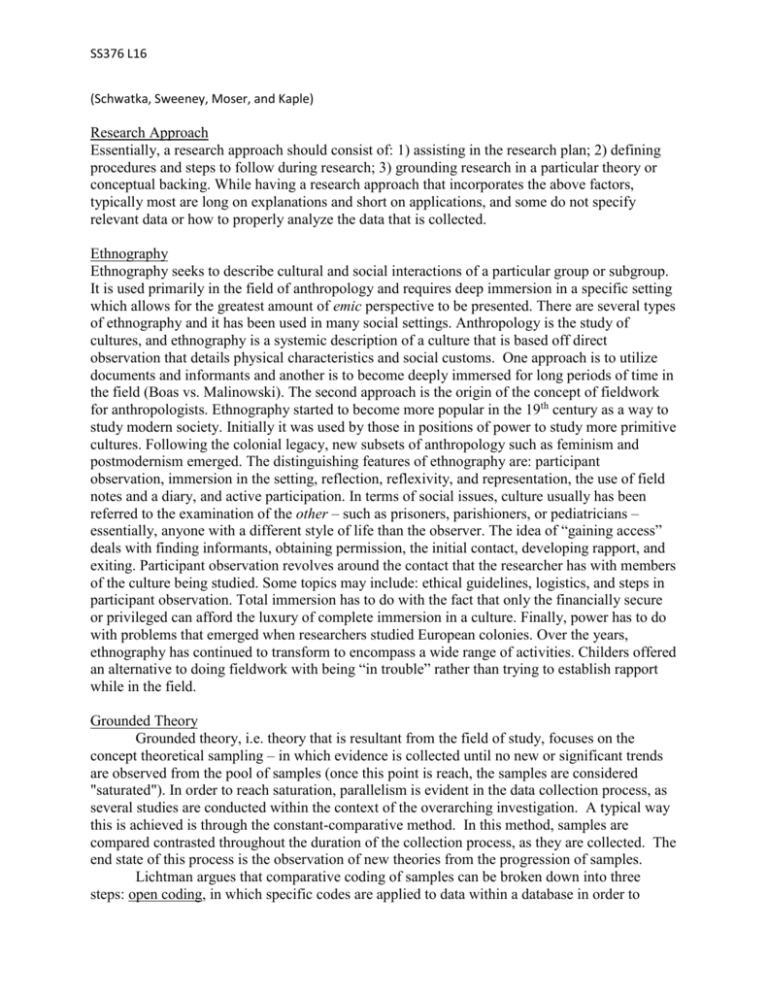
SS376 L16 (Schwatka, Sweeney, Moser, and Kaple) Research Approach Essentially, a research approach should consist of: 1) assisting in the research plan; 2) defining procedures and steps to follow during research; 3) grounding research in a particular theory or conceptual backing. While having a research approach that incorporates the above factors, typically most are long on explanations and short on applications, and some do not specify relevant data or how to properly analyze the data that is collected. Ethnography Ethnography seeks to describe cultural and social interactions of a particular group or subgroup. It is used primarily in the field of anthropology and requires deep immersion in a specific setting which allows for the greatest amount of emic perspective to be presented. There are several types of ethnography and it has been used in many social settings. Anthropology is the study of cultures, and ethnography is a systemic description of a culture that is based off direct observation that details physical characteristics and social customs. One approach is to utilize documents and informants and another is to become deeply immersed for long periods of time in the field (Boas vs. Malinowski). The second approach is the origin of the concept of fieldwork for anthropologists. Ethnography started to become more popular in the 19th century as a way to study modern society. Initially it was used by those in positions of power to study more primitive cultures. Following the colonial legacy, new subsets of anthropology such as feminism and postmodernism emerged. The distinguishing features of ethnography are: participant observation, immersion in the setting, reflection, reflexivity, and representation, the use of field notes and a diary, and active participation. In terms of social issues, culture usually has been referred to the examination of the other – such as prisoners, parishioners, or pediatricians – essentially, anyone with a different style of life than the observer. The idea of “gaining access” deals with finding informants, obtaining permission, the initial contact, developing rapport, and exiting. Participant observation revolves around the contact that the researcher has with members of the culture being studied. Some topics may include: ethical guidelines, logistics, and steps in participant observation. Total immersion has to do with the fact that only the financially secure or privileged can afford the luxury of complete immersion in a culture. Finally, power has to do with problems that emerged when researchers studied European colonies. Over the years, ethnography has continued to transform to encompass a wide range of activities. Childers offered an alternative to doing fieldwork with being “in trouble” rather than trying to establish rapport while in the field. Grounded Theory Grounded theory, i.e. theory that is resultant from the field of study, focuses on the concept theoretical sampling – in which evidence is collected until no new or significant trends are observed from the pool of samples (once this point is reach, the samples are considered "saturated"). In order to reach saturation, parallelism is evident in the data collection process, as several studies are conducted within the context of the overarching investigation. A typical way this is achieved is through the constant-comparative method. In this method, samples are compared contrasted throughout the duration of the collection process, as they are collected. The end state of this process is the observation of new theories from the progression of samples. Lichtman argues that comparative coding of samples can be broken down into three steps: open coding, in which specific codes are applied to data within a database in order to SS376 L16 organize their meanings, axial coding, in which general thematic claims on the nature of the coded data is made, and finally selective coding, in which the key concepts of a working theory are established. A simple axiom guides Lichtman's view of comparative coding: "initially comparing data set to data set, later comparing data set to theory." (Dick, n.d.). Lichtman also brings up that in conducting grounded theory through comparative coding, one must carefully specify and approach the problem of experimental participants, must decide on how to code, and must be capable of working on data analysis while simultaneously collecting it. In terms of applicable fields, grounded theory has been widely used in sociology: ranging from public figure research, art studies, web-based research, and business research. Basically, wherever structure and order are relevant in a study, and there is a wide availability of quantitative information, it will be useful. Otherwise these factors may serve as limiting, especially when theoretical sampling to the point of saturation proves difficult or impossible for the study in question. One must also realize that in grounded theory case studies, the word "theory" is used in a much looser context than it is traditionally: it is not a result of carefully collected scientific data, but a conclusion from a series of consecutive observations. Finally, Lichtman warns that while the comparative-coding process is readily outlined, it is rarely followed in actual study. Phenomenology The purpose of phenomenology is to describe and understand the essence of lived experiences of individuals who have experienced a particular phenomenon. Three Trends Observed: 1) Use of phenomenology method in a variety of disciplines education, nursing, adult learning, allied health fields, art education and special education 2) Broadening scope of interest in phenomenology worldwide facilitated, in part, by the internet and ease of travel throughout the world 3) Expansion, modification and reinterpretations of the application of the phenomenological method There are 3 steps in the phenomenological method: 1) Identify an experience and attempt to decipher and understand the experience at a deeper level. Do not just describe the experience at face value. 2) Bracket your thoughts which is an attempt to set aside your own ideas and beliefs about an experience so outside influence does not corrupt findings. 3) Phenomenology is a philosophy and a method of inquiry. Case Study The case study approach is an in-depth examination of a particular case (eg: individual, program, event, project, work unit, or concept) or several cases (p. 118). This approach values multiple perspectives when examining cases. Since there is little to no organizational structure to this method, it is up to the researcher to set limits or boundaries when examining a case study (eg: who is being interviewed and how many people are being interviewed). Case study is different due to the fact that there are not philosophical underpinnings to this approach. You are simply just studying an entity. However, this entity must be detailed and specific. To make these cases SS376 L16 specific, you can limit it to a characteristic, trait, or behavior (eg: study children with a learning disability) or limit it to one type of situation (eg: something special and unique like 9/11). The distinguishing features for the case study approach include: objective is to increase knowledge and bring about change in what is being studied, empirical inquiry, contemporary phenomenon, and real-life context. With this in mind there are some special issues to understand. When selecting cases there are three different types to utilize: typical, exemplary, and unusual/special. Typical is an entity that is characteristic of others in the same set (eg: store in strip mall with average sales). Exemplary is an entity that is the best, most outstanding in the set (eg: store in multiplex mall with excess sales). Unusual/special is an entity that has special practices or stands out for whatever reason in the set (eg: store that sells special merchandise that no one else does). However, words of caution: make sure your case study does not become too generalized; you have to keep it specific. The big takeaway is that if you have a specific entity to study and your question is involved in asking what happened when the program was developed or how an individual behaved, you are good to go to use the case study approach. Narrative Narrative research inquiry is a group of approaches that rely on the written or spoken words or visual representations of individuals (p. 124). This means personal storytelling is involved. There is an emphasis on the lives of individuals as told through stories. However, this is not just story time; research of this type involves a researcher interpreting or making meaning of the told story. You can do this by following these steps: collect an objective set of experiences (chronologically or in life stages), gather actual stories, organize stories into pivotal events or epiphanies, search for meaning in the stories, and look for larger structures to help explain the meaning in the stories. The distinguishing features for the narrative approach include: reliance on the story aspect of the data, gathers data in the form of stories, presents data in the form of stories, often uses alternative presentation forms. With this in mind there are some special issues to understand. Firstly, you will probably not know if you have gathered insufficient information until you organize your data. Secondly, you will most likely have to work in a collaborative manner with storytellers because they own the story. Lastly, you are retelling story so make it clear and coherent. However, words of caution: understand the context to your story before you interpret it and remember, there is not wrong answer because it is based off of interpretation and sensibility of the researcher. The big takeaway is that you have a story in which you add your own interpretation and analysis; this approach is not just story time.

